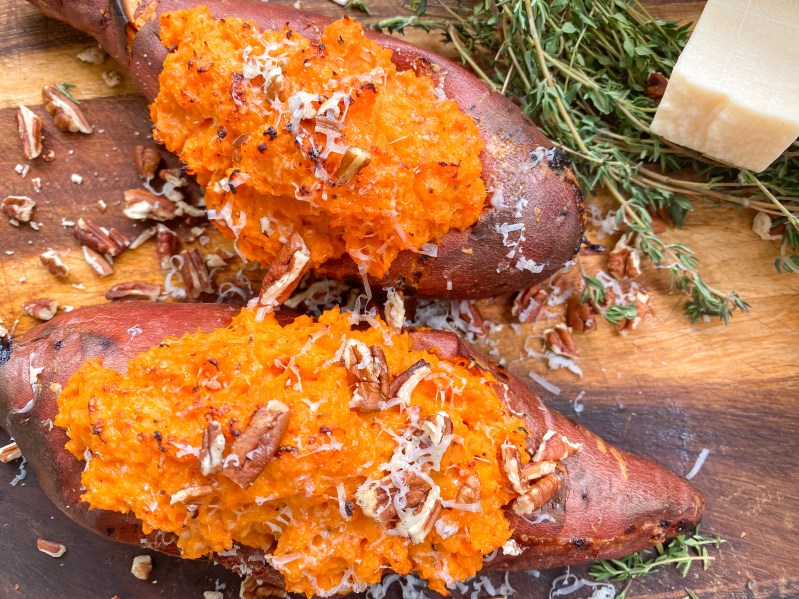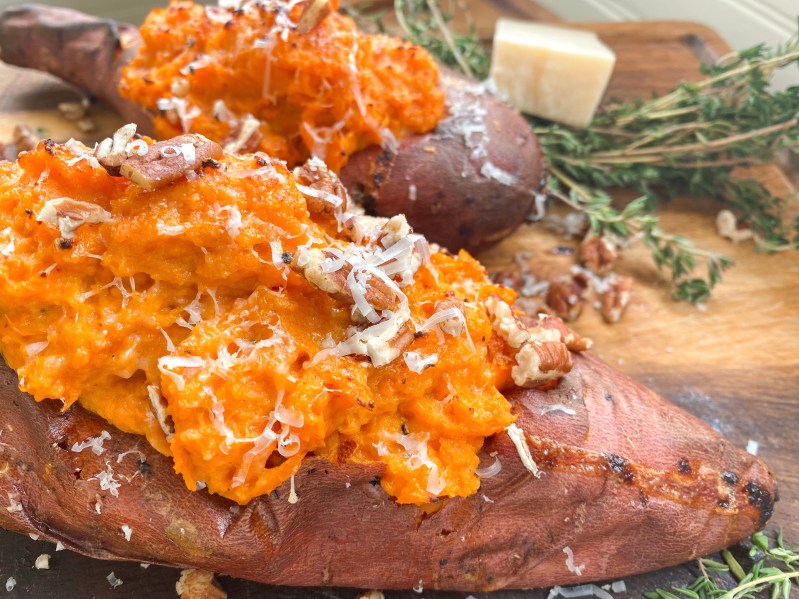
Twice-baked potatoes are one of those indulgently satisfying, comforting, cheesy sides that warm to the absolute core. But when you twice-bake a sweet potato, all of those comforting feelings get a savory autumn upgrade that’s unparalleled in both taste and coziness. Twice-baked sweet potatoes are the perfect fall dish. They’re simple enough to enjoy as dinner itself, sitting on the sofa under a big quilt, or as an impressive side dish on a holiday as special as Thanksgiving.
Of course, sweet potato recipes are abundant this time of year, but this one, in our opinion, takes the cake. Baking sweet potatoes is exactly like baking regular potatoes. Simply wash, pierce with a fork, rub a little oil for crispy skin, and bake. Once cooked through, that beautifully orange filling is scooped out and mixed with just about anything you like, from cream cheese to butter and herbs to marshmallow fluff. This is a great recipe to experiment with all of your favorite fall flavors.

Twice-baked sweet potato recipe
Ingredients:
- 2 sweet potatoes, cleaned and pierced with a fork
- 1 tablespoon olive oil
- 1/2 stick butter, melted
- 1/4 cup heavy whipping cream, warmed
- 2 cloves garlic, minced
- 1 tablespoon fresh thyme leaves, minced
- 1 tablespoon maple syrup
- Salt and pepper to taste
- Toasted pecan pieces (optional garnish)
- Gruyere cheese, finely grated (optional garnish)
Method:
- Preheat oven to 425F.
- Rub sweet potatoes with olive oil and place directly on oven racks.
- Bake sweet potatoes in the oven until completely cooked through, about 45-60 minutes, depending on the size of the sweet potatoes.
- Cool cooked potatoes until they are easy to handle, then cut a wide slit in the top of each, scooping out most of the flesh inside, and transfer to a mixing bowl.
- Using a potato masher, mash together sweet potato filling, butter, cream, garlic, maple syrup, thyme, salt and pepper until smooth.
- Using a spoon, carefully fill the hollow potato skins with the prepared filling and top with cheese, if desired.
- Broil on high for 2-3 minutes until warmed through and the top is starting to brown.
- Garnish with additional gruyere and pecan pieces, if desired.
- Serve immediately.
Twice-baked sweet potato tips and tricks
- Pricking potatoes (regular or sweet) with a fork before baking is an important step that shouldn’t be skipped. It allows steam to escape so that the spuds don’t explode in the oven. This doesn’t happen all the time, but why risk it?
- How long to bake sweet potatoes really depends on their size. Start checking them at around 40 minutes. When you pierce them with a fork, it should slide with no resistance.
- When scooping out the sweet potato filling, be careful to leave a bit of flesh inside the skin. If all of the flesh inside is removed, the skin may tear and will be difficult to handle.
- We love the added sweetness of maple syrup in this recipe, but if you prefer your sweet potatoes more on the savory side, feel free to leave it out. Alternatively, you could add a little sweetness with honey or agave nectar.
- If you do like a lot of sweetness, you can always add more with your topping choices. Marshmallows are delicious on twice-baked sweet potatoes. Simply press a few onto the top of the filling before broiling for a sinfully sticky and delicious addition. You could also use candied pecans instead of toasted ones for a sugary crunch.




